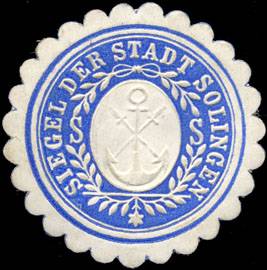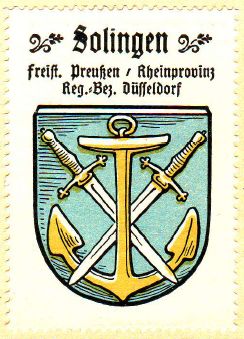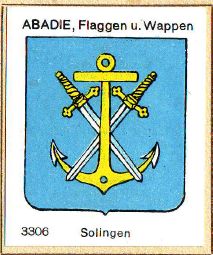Solingen: Difference between revisions
Knorrepoes (talk | contribs) m (Text replacement - "{{de}}" to "") |
Knorrepoes (talk | contribs) m (Text replacement - "|'''English''' ↵| {{blazon wanted}}↵" to "|'''English''' | blazon wanted ") |
||
| Line 17: | Line 17: | ||
|- | |- | ||
|'''English''' | |'''English''' | ||
| | | blazon wanted | ||
|} | |} | ||
Revision as of 12:35, 7 April 2023
SOLINGEN
State : Nordrhein-Westfalen
Urban district (Stadtkreis) : Solingen
Additions : 1889 Dorp; 1929 Gräfrath, Höhscheid, Ohligs, Wald; 1974 Burg an der Wupper
| German | In Blau ein goldener Anker, zwei silberne, schräg gekreuzte, gestürzte Schwerter mit goldenen Griffen überdeckend und mit den Spitzen verschränkt. |
| English | blazon wanted |
Origin/meaning
The arms were officially granted on July 7, 1935.
Solingen became a city in the early 15th century. The city rights were granted by the Dukes of Jülich. The oldest seals, known since 1468, show the patron saint, St. Clement or the lion of Jülich.
In the 17th century the present arms appear (oldest known image from 1670). The saint is replaced by his symbol, the anchor. The swords symbolise the local iron industry, which already in the 17th century was famous for its swords and knives.
The large arms of the city, which are rarely used, if at all, have two wolves as supporters and a mural crown. The city only uses the mural crown.
| Seal from around 1900 |
The arms by Hupp in the Kaffee Hag albums +/- 1925 |
| The arms in the Abadie albums |
The arms on a 1960s matchox label |
| The arms on a special cancellation 1982 with Gouda |
Literature: Stadler, 1964-1971, 8 volumes.





